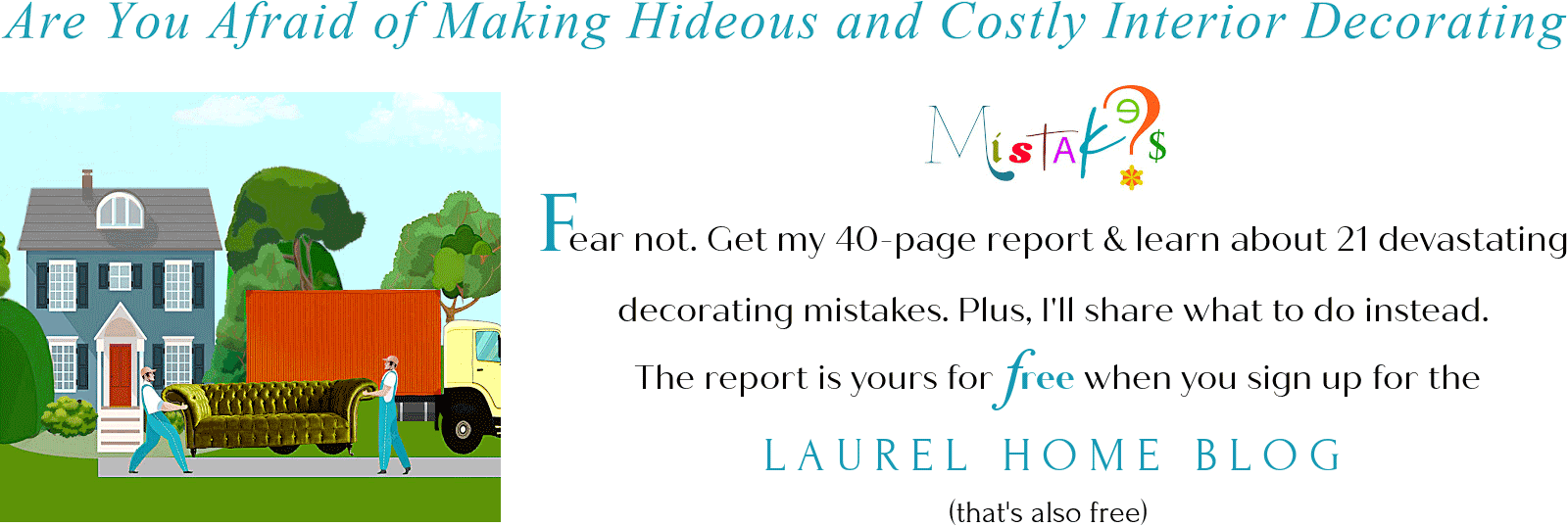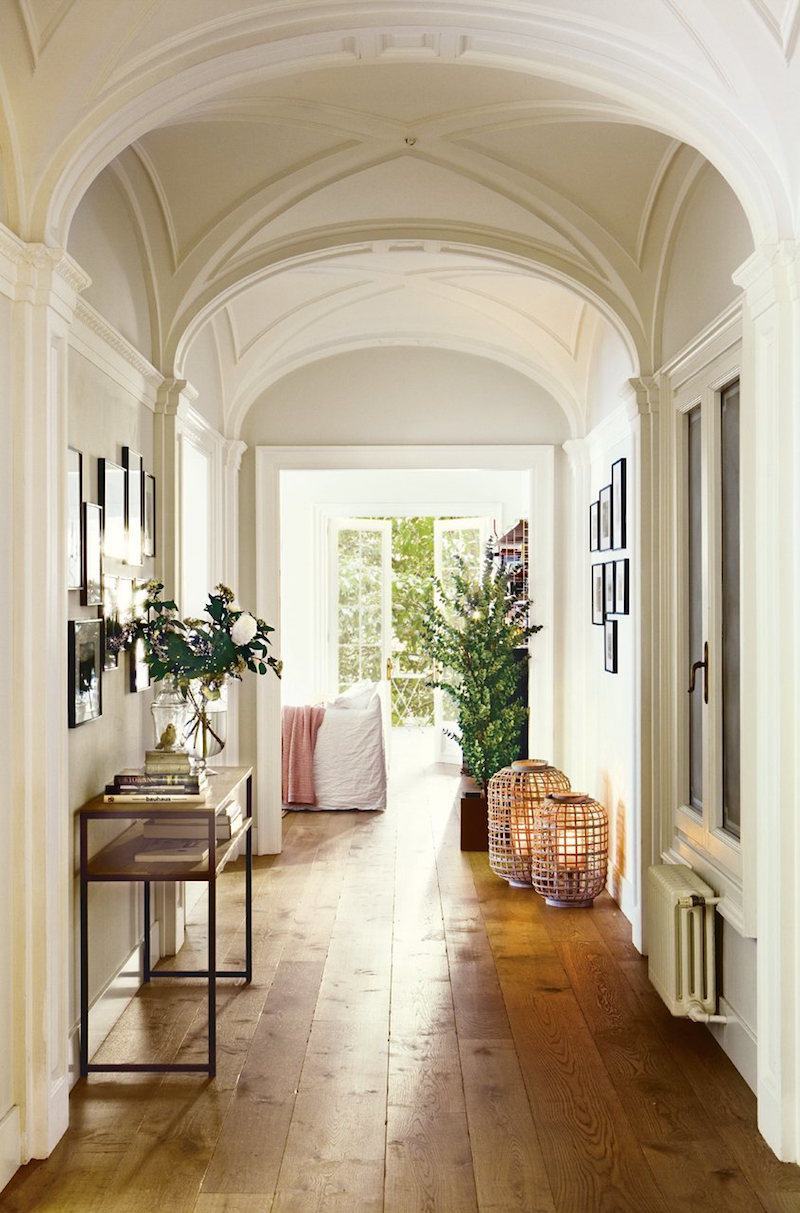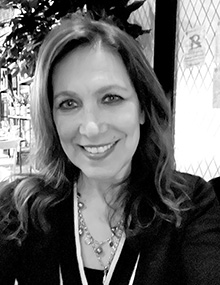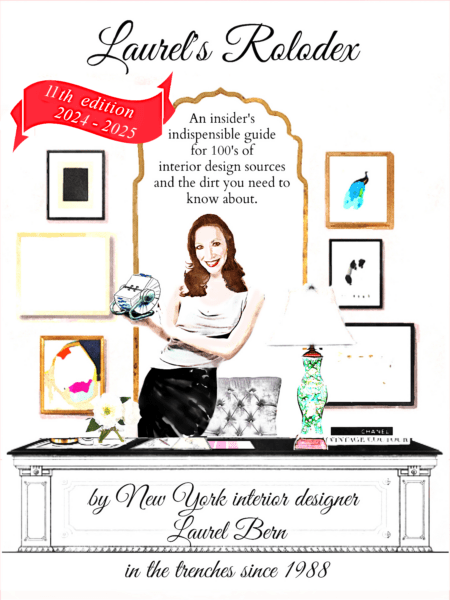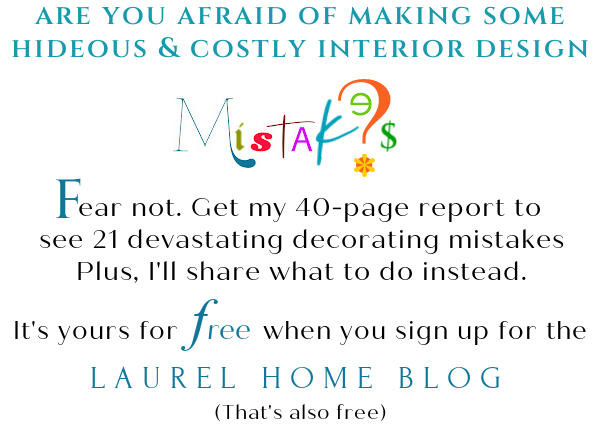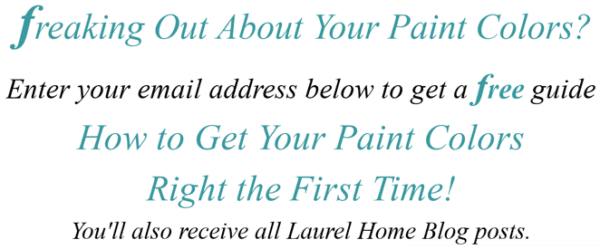Hardwood floors. This subject is so broad that one could have an entire blog devoted to hardwood floors, not just one blog post! I hope you’ll discover some things you didn’t already know that will help with your hardwood floors.
So let’s jump in.
There are three basic types of hardwood floors.
- Solid (the most common kind)
- Engineered
- Laminate
Solid hardwood flooring is just what it says. It is most commonly made from oak, usually red oak, but sometimes white oak. There are many different types of wood and ways the wood is cut
- plain sawn
- quarter sawn
- rift sawn, etc.
Are you asleep yet? ;]
Therefore in the interest of getting into other useful information, here’s a fabulous link that is a terrific reference for everything you ever wanted to know about the technical aspects of hardwood flooring.
Laurel’s number one recommendation for hardwood floors is:
Always use a highly experienced master craftsman for hardwood flooring installation and refinishing.
HOT TIP:
The wood needs to sit in the room for a few days before installation, especially if you live in a northern climate (frigid winters, hot, humid summers). I think it’s better to install the wood during the humid summer. As you may know, wood swells in the humid summer months and shrinks in the bone dry winter months. There is nothing worse than a new wood floor that’s buckling because the installer didn’t allow for the swelling of the wood.
A good installer will leave a very tiny, almost invisible space between the floorboards in any case.
Engineered Hardwood Flooring is sometimes referred to as laminate, but it is not laminate in that engineered hardwood floors do have a thick layer of natural wood on top. That means it can be sanded and refinished but how many times depends on how thick that layer is.
Drawing by Other Metro vtpf.com
EHF is constructed in layers of plywood underneath the finished floor layer. The plywood base plus veneer makes this a more stable, consistent product. Therefore, it is beautiful for high moisture areas and the only hardwood flooring that can go directly over concrete.
It is also terrific for basements or if your ground floor is built on a slab. Engineered hardwood floors are also the preferred wood flooring product for radiant heated floors if you should be so lucky to have that.
Below is a white oak wide plank engineered hardwood floor.
Laminate does not belong in this group. It is not hardwood flooring. It is pressed cardboard with an image of natural wood stamped on it. Fake. And you’re not to use it–ever. Understood? ;] ;] ;]
Okay. Okay! Stop whining, please. I understand. You have a basement that you spent $80,000 trying to keep dry, or you live in a heavy-duty hurricane zone.
It’s laminate or bust.
Alright. Fine. I will soften my stance a little. :]
Laminates have come a long way from the cheap, totally obvious fraud to something that resembles natural hardwood floor pretty darned well. Plus, it’s fade-resistant and scratch-resistant, great for moisture and high-traffic areas.
However, as previously stated, it can never be refinished, as it’s not real wood. There are also some pretty good vinyl fakes out there. I’d far rather you have a good fake than some hideous pinky beige tile.
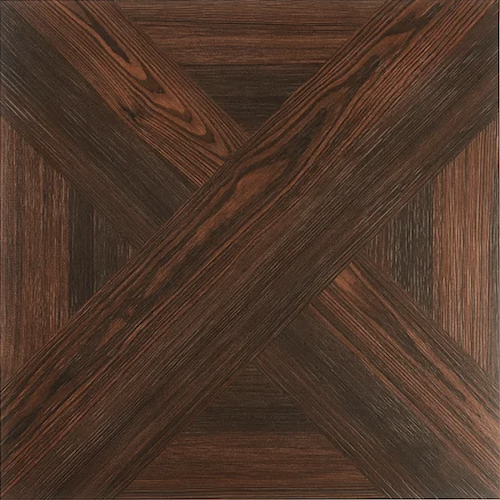
Balsa porcelain wood look wall and floor tile – Wayfair
In addition, there are also porcelain tiles that do an excellent job of mimicking real hardwood.
If it were me, and I wanted the look of hardwood, I’d probably go this route. I think the above “Versailles” pattern is incredibly handsome. It comes in four other colorways, as well.
This is a fantastic product for humid climates and bathrooms if you love the warmth of hardwood floors in a bathroom but are nervous about putting down natural wood. The only drawback is that it is hard underfoot. However, you can use area rugs with a thick pad, which will undoubtedly help a lot.
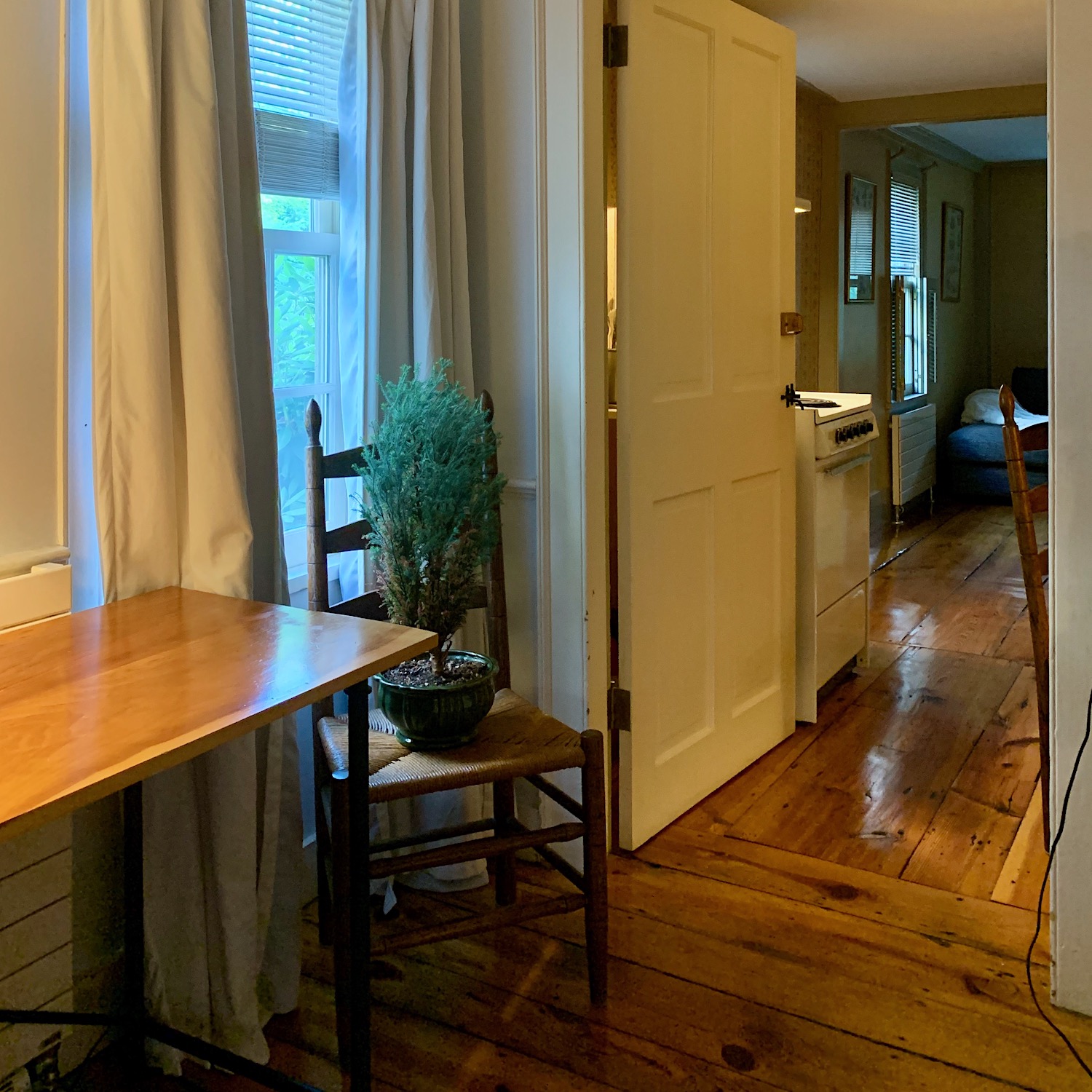 However, remember the exquisite heart pine antique wood floors at the Elm Street Inn, Northampton, MA? photo LBI You can see more of this charming Airbnb here. I recommend it highly. I’m mentioning it because they continued the antique pine into the bathrooms. I loved it, and it looked to be holding up quite well.
However, remember the exquisite heart pine antique wood floors at the Elm Street Inn, Northampton, MA? photo LBI You can see more of this charming Airbnb here. I recommend it highly. I’m mentioning it because they continued the antique pine into the bathrooms. I loved it, and it looked to be holding up quite well.
Let’s move on to Finishing Your Hardwood Floors.
I want to work backward and discuss the topcoat applied to your hardwood floors. All hardwood floors require a protective coating.
Although did you know that in the 19th century and earlier, they usually did nothing whatsoever to protect the wood? You can read more about it here.
However, in the 19th century, if the hardwood floors were finished, they used stain, filler, oil, paint, varnish, shellac, and wax, or a combination of two or more of these materials.
To preserve the natural color of oak and maple hardwood floors, they were often finished with a colorless wood filler, white shellac, light-colored wax, or pale varnish.
If a deeper color was desired, they used shellac or dark varnish. Before any finish was applied, the floor was made smooth by planing and sandpapering parallel with the wood grain and then swept and dusted with a soft cloth before the finish was applied.
Here are the main types of hardwood flooring finishes.
- Wax
- Tung Oil
- Water-Based Polyurethane
- Oil-Based Polyurethane
(note: I have also seen lacquered and varnished floors, but they are rare and have problems like the finish will come up if certain things spill on it. So don’t recommend them)
Wax
Did you ever go into an old home, and perhaps it has wide-planked pine or walnut floors that have a deep, rich, warm, gorgeous luster? That finish is most likely wax.
Yes, it is beautiful, but it comes with a price.
- There is a lot of maintenance required. The wax usually needs to be reapplied about once a year. And it’s a labor-intensive project. There is a good tutorial here about reapplying polish.
- Waxed floors do not like water. To find out if you have a waxed floor. Drop a bit of water in an inconspicuous spot and wait a bit. If the finish turns white-ish— you have a waxed finish. Therefore, it’s not the best for kitchens. Find out what other type of finish you have. Here is a great link.
- Once you’ve used wax, it’s challenging and ill-advised to use a traditional polyurethane, be it water or oil-based. If you don’t get it all up, you’re going to have a big bloody mess on your hands. Or rather, your feet! (unless you walk around on your hands). The reason is poly doesn’t stick well to anything waxy or oily.
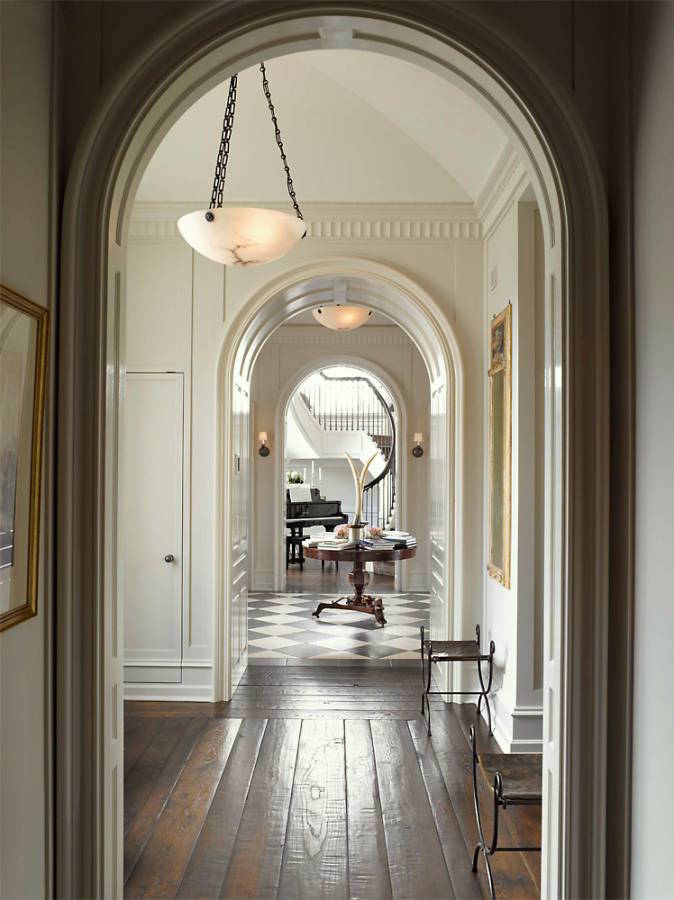 Austin Patterson Disston Architects
Austin Patterson Disston Architects
I have had clients who have a waxed finish and won’t do anything else. Ever. That is how much they love it. Of course, they have the means to maintain this type of finish.
Tung Oil
Another fabulous product that is not as well-known as Waterlox is Tung Oil. You can find out much more from the link. It has been around for about 100 years. It is a natural substance but quite noxious when applied.
You should wear a mask and have excellent ventilation when using this product. After several days, it dries to a rich, beautiful, durable sheen. It is easy to reapply, and the floors are easy to maintain. Unlike wax, you can use a damp mop to clean the floors. (more about cleaning later). There are also waxes that you can put on top of it. It’s all in the link.
Does anyone have any experience with this stuff?
I’ve read several reports from people who love it!
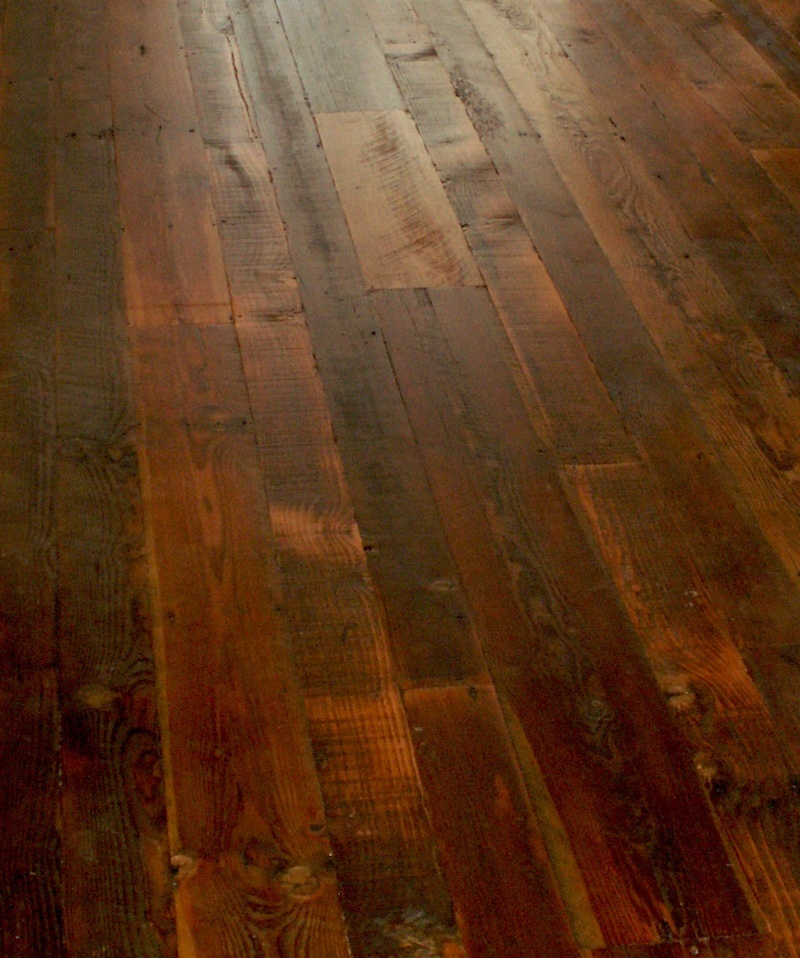
Like wax, Waterlox requires reapplications every year or so. However, if you get tired of that, after it’s good and cured, you can have it screened and apply traditional poly. I read this in a few places, however, do check with your flooring professional.
Polyurethane.
“Poly” is the most common floor finish these days. And, there are so many in the marketplace, with new ones cropping up all of the time.
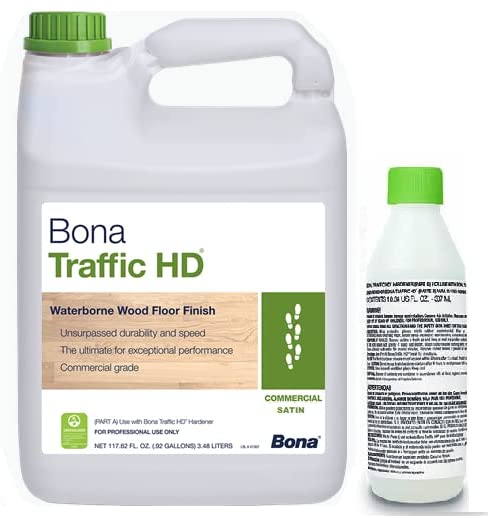
One popular brand is Bona. It comes in both water and oil-based.
Water-based Polyurethane
Most of the time, I hate it, especially on dark floors. I don’t care what your flooring guys says; I have never seen one that doesn’t look like plastic or holds up very well. Never. (But, maybe Bona is different?) However, there are some very compelling reasons to use water-based polyurethane.
- far less odor
- speedy drying time
I have read that the trick in having a water-based poly hold-up well is using FOUR COATS. Yes, four coats of water-based poly. However, with only two to three hours of drying time, in between coats, unless it’s a huge floor, that might take only a couple of days to apply all four coats!
Oil-based Polyurethane
Well… I bet that you were going to say that I love it! It’s true; I DID love it. That is until the EPA BS came into effect. They changed the formulations. Can you still get the old formulation? Yes, I think so, but only in pint-sized quantities. They had to get 24 pints for the Bronxville kitchen to do the job!
Why oil? Oh my. I had it in my home in Goldens Bridge. It was gorgeous and dried to a rich, warm, tawny luster that only gets better with time!
This poly does deepen the color a little. However, it held up beautifully! Seventeen years later, it was still in excellent condition. This was despite two wild and crazy boys, a 200 lb husband, Peaches (our dearly departed kitty), and me, but I walk around on my tiptoes. ;]
Well, Laurel, are you going to tell us what you used?
Oh, yes… sorry. It was this stuff.
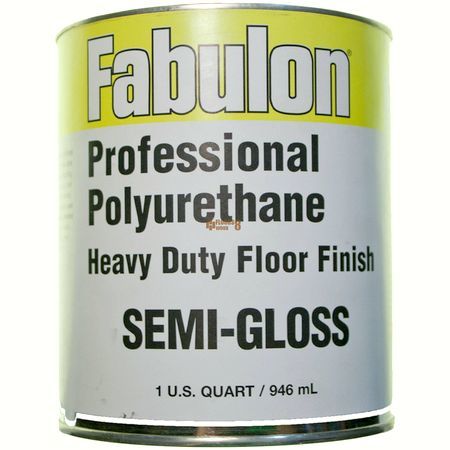
Fabulous Fabulon! But, I can’t find it, at this time, at all.
Are there any drawbacks to oil-based poly? Yes. It has an amber tinge, but that is good for brown stained floors. It’s not a good thing you’re doing a white floor. In that case, you must use a clear water-based poly.
I have read that oil-based poly yellows over time. I did not notice any yellowing in 17 years of our Fabulon floor finish. It did fade a good amount by the south-facing bay window, so do get your windows U.V. protected if they aren’t already.
Can you put water-based polyurethane over oil-based and vice versa?
That’s an excellent question. Here’s my answer. Suppose you put down oil and decide after one coat that you can’t stand the fumes. Ideally, you’re supposed to wait 30 days for the oil to be thoroughly cured. However, I found a forum where a master floor guy said that he does this all the time, maybe waiting just a few days and no problems. You can read that here. It’s pretty interesting. However, I think it is easier to apply oil over water, but as long as it is very dry, you shouldn’t have any problems.
Can you put a waxed finish over polyurethane?
Many years ago, I had a client who told me that this is what she had done. Her floors looked alright. But here’s the deal. Once you put wax on the floor— of any kind, it is a waxed floor and will forever require more waxing and will give you potential problems down the road. I don’t advise it. Either do poly OR wax.
If you decide or someone else decides years down that they want to change the color of the floor; you could have problems.
I recommend first removing all the wax with mineral spirits, and then, of course, the floor will need to be sanded and then stained. If you want to be sure of a great result, I would go back to wax. I am not saying you can’t use traditional poly, but I have had clients who’ve had problems with poly adhering. As stated earlier, polyurethane does not stick well to wax or oil.
And worse yet?
Stuff like Mop ‘n Glo. It should be called Mop & Glop.
It contains silicone. Silicone is your floor’s worst nightmare. STAY AWAY!
The same goes for Murphy’s oil soap.
What?! Murphy’s Oil Soap?
Yes, my dears, it will be the death of most floor finishes.
It is made from vegetable oil and detergent.
You will never get it all out as it’ll penetrate the tiny pores and hairline cracks. Plus, it’ll seep deeply into the wood underneath the poly coating. Over time, it will derail your finish into a softy gloppy mess as it breaks it down.
I don’t care what their commercials say; the stuff seems innocuous enough; however, it’s not.
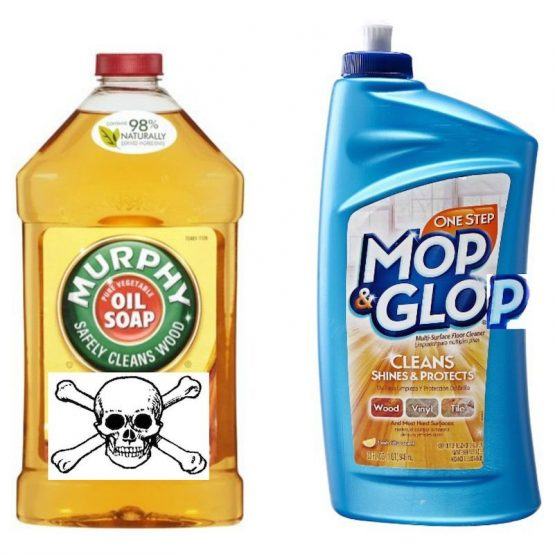
Please note. When you are cleaning your hardwood flooring with a poly coating, you are cleaning the poly, NOT the wood! Would you use Murphy’s Oil Soap on your windows? Case closed.
Here’s a simple recipe you can make at home to clean POLYED hardwood floors
Take a gallon of warm water. One capful of vinegar and maybe one drop (yes, one drop) of dishwashing liquid or something like Fabuloso. You can also throw in a capful of rubbing alcohol. And that is all.
You do not need to go out and get some expensive floor cleaner. BTW, you CAN damp polyurethaned mop floors. Not soaking, but damp is fine. More importantly, than mopping is keeping the hardwood floors vacuumed. Swiffers are good too. (Remember the Swiffer-sock post?) Keeping the floor dust-free will elongate the life of the finish and help prevent scratches.
NOTE: This is only for polyurethaned and tung oil-finished floors.
Waxed floors should not be damp mopped unless it is dried–immediately! And then, the wax may need to be reapplied. Also, look into Restore-A-Finish for waxed hardwood flooring.
“Oh my, Laurel. Now, I’m worried. How do I know if the previous people used that Murphy Oil stuff? The house was empty when we bought it!”
Well, if you are still on speaking terms with them, ;] I would ask, or if not, perhaps your realtor can get this information for you. Better yet. Ask before you buy the house.
However, I have read that a mixture of trisodium phosphate and water followed by a clear rinse should eliminate a lot of the MOS residue. But please know that you still might have problems. Consult with your flooring expert.
What kind of problems?
Here. These kinds of problems. (see below) I should know.
Below is a pic I took several years ago outside my old bathroom in Bronxville, NY. Fortunately, it is only in this one spot.
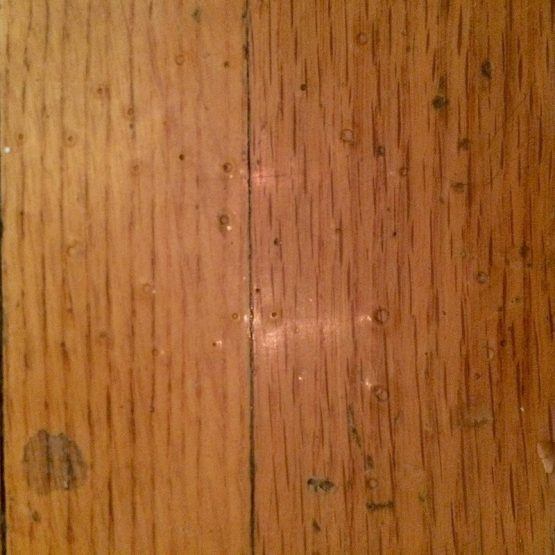
See those bubble-y things. Nice, huh? Those are called “fish eyes.” And, the brown spot is where the finish is up altogether. This happens when a floor is finished, and there is something waxy or oily underneath. I cannot stress enough to be very careful when refinishing floors that are not virgin wood if you are unsure what has been used on them!
One day, I’ll take care of it. (Nope, haha! I never did.)
The floors are nearly 100 years old, and they certainly do have a lot of character!
This reminds me. If your issues don’t affect the stain, you can frequently have your floors screened which is like taking the top layer of poly off. Then the flooring folks will apply another one to two coats of poly.
Hardwood Flooring Stains
No matter your topcoat finish, all hardwood floors can be stained. While you don’t have to stain, doing so will bring out the richness of the natural wood. There is another method for changing the floors’ color, and that is bleaching and staining them a lighter color.
You can read all about staining and painting floors white, whitewashing, and other techniques here.
The most crucial point about stains is that they can completely dry before any top coating is applied. If it’s summer and humid, that will be at least 72 hours. It might be less, and if your flooring guy is fine with less time, then so be it.
What color stain is good?
The choice is a matter of preference, the style of decorating you are going for, and the home itself. With an older home that is traditional in style, I generally prefer a darker floor. It is richer and more authentic. I have always used Minwax stains and never had a problem with them. However, I’m not a fan of their polyurethane.
I’ve looked at just about every wood-toned color they make, and here are my favorites:
English Chestnut. Hands down, my fave. It is the perfect color IMO. Rich and deep, with a hint of red but not RED, if you know what I mean.
Red Mahagony. It is also very lovely but better over white oak than red oak as it can go too red with red oak.
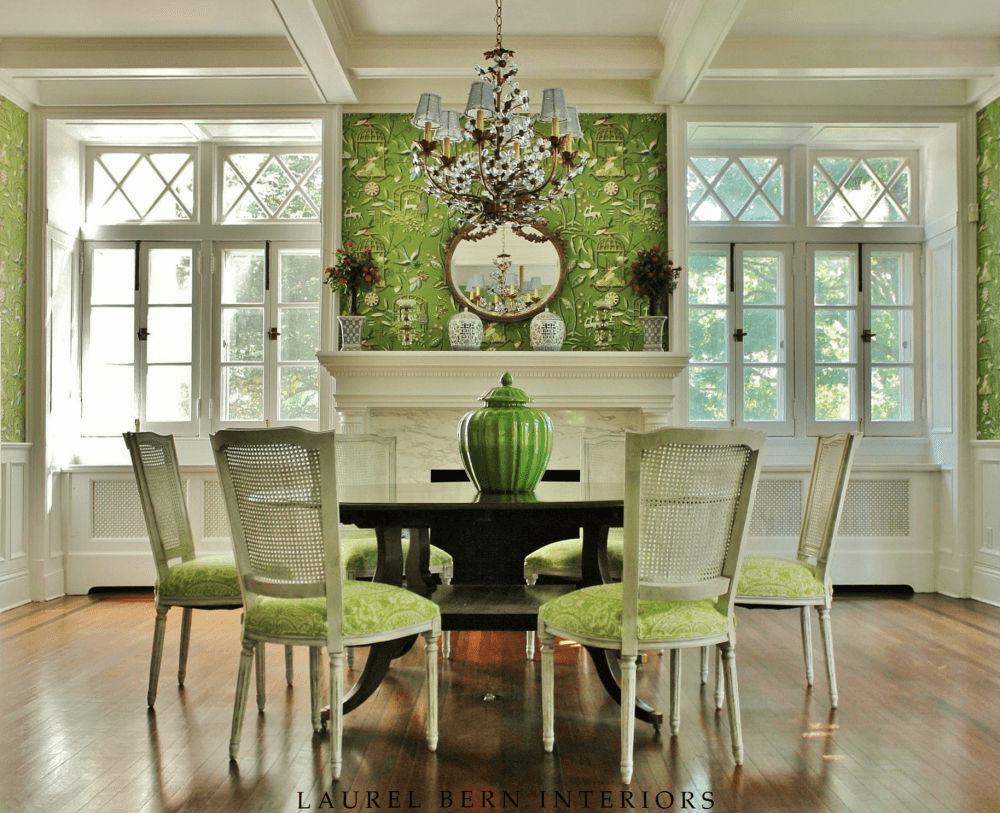 Bronxville Dining Room – photo by me
Bronxville Dining Room – photo by me
This is the red mahogany stain in the dining room we did several years ago!
Golden Oak is what we used in our old townhouse. (see below) I chose this color because I was going for a more country look, and our place was flooded with light. It is the perfect color for that home. (see below). It looked a little darker and redder than it does on my monitor.
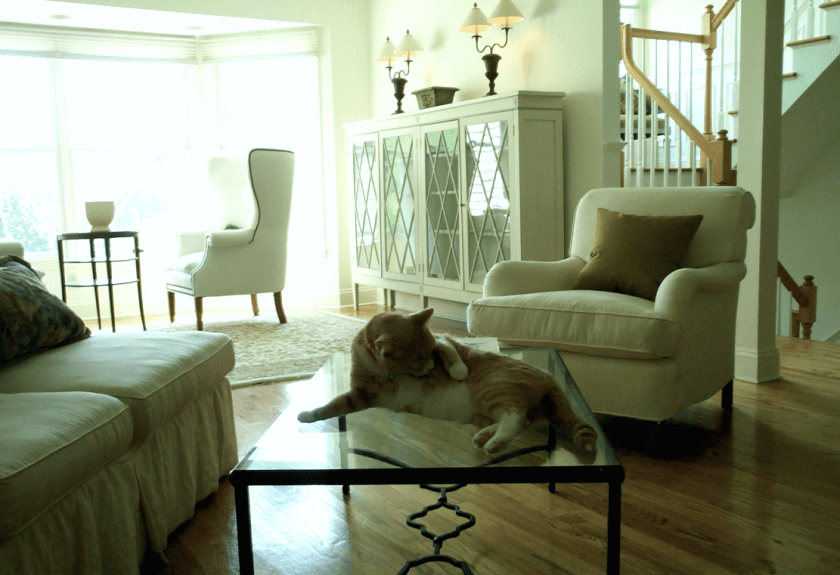
Awww, cutie-pie Peaches grooming himself in our old living room circa 2002.
50/50 Special Walnut and Jacobean. My old boss had this color in her home, and it was a deep, rich non-red brown, but not yellow.
One of my most objectionable stains is a deep brown with a yellow tinge to it. Ashy, no-color or pink undertones, are not very attractive either. I’m not a fan of anything gray or ashen for hardwood floors unless you’re going for a very specific look like Bobby McAlpine, for instance, and not just buckling into a trend.
Any others? Nope. not really.
What if I have two or more kinds of wood in the house?
I see that all the time. Most of the time it’s really best to just use the same color throughout the house, but of course, I would always test.
Testing floor stains is essential!
The best way is right on the unfinished floor. The color is going to change when it’s dry. And that’s going to begin in a few minutes. Generally, I recommend waiting a day or two, and then the guy can come over and lay some poly over it to bring out the actual color.
Will your floor look exactly like the sample?
Probably not. Expect it to be lighter or darker than the sample. It’s not an exact science and the wood may or may not absorb the stain in the same way on every floorboard.
Please feel free to pin the graphic below onto your Pinterest boards for reference.

Phew! That was long and I’m sure I’ve left out some important points too.
Or, maybe you disagree with me on some of this. That’s okay. You can get three wood flooring contractors in a room, and all three will have a different idea about how things should be done. It’s not an exact science, except for Murphy’s Oil Soap.
xo,

Related Posts
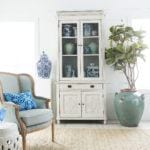 Painted Wood Furniture – Cringe Worthy, Dated, or What?
Painted Wood Furniture – Cringe Worthy, Dated, or What? Window treatment styles – How to select color, type, pattern
Window treatment styles – How to select color, type, pattern No Windows? No Problem. Help for a Windowless Room
No Windows? No Problem. Help for a Windowless Room My 20 All-Time Favorite Benjamin Moore Paint Colors
My 20 All-Time Favorite Benjamin Moore Paint Colors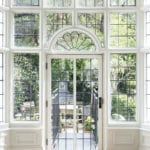 Original Old Home Details – Is it OK to change them?
Original Old Home Details – Is it OK to change them? 30 Cheap Table Lamps + Sources + What Size to Get
30 Cheap Table Lamps + Sources + What Size to Get Is Your Baseboard Heater or Radiator Making You Crazy?
Is Your Baseboard Heater or Radiator Making You Crazy?

